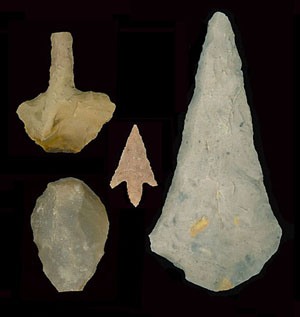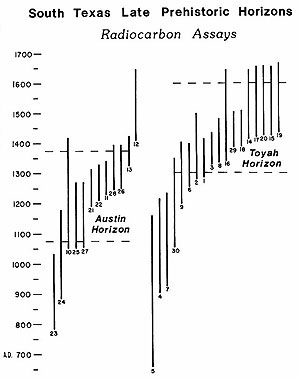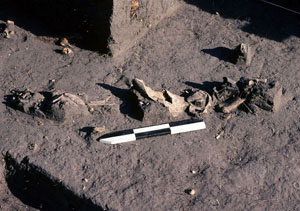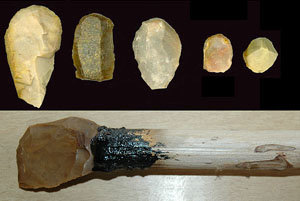Toyah Horizon
The Toyah culture forms one of the latest and most fascinating chapters in the prehistory of a vast area across central and southern Texas that spans some 200 miles east-west and over 300 miles north-south. Based on preserved archeological evidence, peoples with a closely shared material culture, including a distinctive set of stone tools and bone-tempered earthenware pottery, lived throughout this area between about A.D. 1350 until after 1600. This culture coincides with the period during which bison herds “returned” and were periodically (probably seasonally) present in the general region after centuries of absence, leading many researchers to believe that Toyah culture was based on bison hunting. Yet careful studies of the animal bones recovered from several excavated Toyah sites in the South Texas Plains have shown that deer remained the number one big game prey. It is clear that Toyah culture is a complex phenomenon that defies simple characterization.
Most of the Toyah story takes place beyond the South Texas Plains to the north and west and is summarized in the Plateaus and Canyonlands exhibits (see Toyah Culture). But there are two well-documented Toyah sites from deep within the South Texas Plains that have given researchers insight into life during the period. In the late 1970s and early 1980s archeologists from the Center for Archaeological Research at the University of Texas at San Antonio (UTSA-CAR) excavated the Hinojosa site (41JW8) near Alice and the Possum Hollow site (41LK201) near Three Rivers. Both sites proved to be campsites with well-preserved occupational layers left by Toyah groups.
The term Toyah Horizon was first applied to the Hinojosa site to call attention to the perception that the expressions of Toyah culture known in deep South Texas were part of a cultural phenomenon that quickly spread across a very broad geographic expanse. Other archeologists have used the terms Toyah “phase,” Toyah “interval,” and Toyah “culture.” Here we will stick with Toyah Horizon because this cultural expression does seem to represent a rather abrupt intrusion into the region in the 14th century (1300s) of artifacts and technologies that were obviously developed elsewhere, outside the region.
For instance, at about the same time (or just before) the Toyah Horizon spreads across the South Texas Plains, the native peoples of the region adopted the habit of making a particular type of low-fired earthenware known as bone-tempered pottery. Ceramic technology – the use of fire to transform clay into hard ceramic material, especially containers – had long been known elsewhere in North America, for hundreds of years. But this technology was not adopted in southern and central Texas until the 13th and 14th centuries. Exactly when the technology first appears in the region, or who it was that south Texas peoples learned the new technology from, is not known. Nor is it clear whether pottery making spread into south and central Texas from eastern Texas, far west Texas, or the Southern Plains, all areas where ceramics were made hundreds of years earlier. Whatever the precise origins, a distinctive pottery making tradition took hold across the South Texas Plains by the outset of the Toyah Horizon.
Bone-tempered pottery was made by adding crushed animal bone to wet clay, probably deer or bison bones that had been charred first in a fire so they could be crushed into a dry chunky powder. The bone is thought to “temper” or strengthen the clay as it dries. The pottery was made using the coil method and it was typically nicely smoothed and polished and sometimes decorated with a red-ochre slip or post-firing wash, or, less commonly, with simple incised decorations. It was fired in nothing more than a surface fire fueled by brush, grass, or perhaps even buffalo dung. Firing temperatures were relatively low, resulting in earthenware that was tan to gray to reddish in color, with frequent firing clouds and dark cores. Archeologists typically find only small pieces – potsherds often less than the size of a quarter. This low-fired earthenware broke easily and weathered badly when left on the surface. Several vessels from the region have been partially or wholly reconstructed and include ollas (water jugs), simple bowls, and jars. Ceramic pipe bowls and a few figurines are also known, but rare.
The Toyah stone toolkit includes the Perdiz arrow point, beveled knives, end scrapers, and drills made from flakes. This toolkit was well suited for hunting (Perdiz points), butchering (beveled knives), and processing the hides (end scrapers) of deer as well as bison and antelope; the drills were probably used to bore holes in wood and shell. In addition, blade technology reappears in the region after an absence of over 12,000 years (since Clovis times). Using this specialized core reduction technique, parallel-sided flakes called "blades" are removed one after another from specially prepared cores. Not all Toyah groups adopted blade technology, but many did, presumably because this flintknapping technique allowed toolmakers to yield larger numbers of useful pieces (blades) from specially prepared cores than was possible with conventional flintknapping methods. Perdiz points, flake tools, and small end scrapers were all made from blades (as well as from ordinary flakes).
To learn more about the Toyah Horizon of the South Texas Plains see the Hinojosa exhibit and the Possum Hollow section of the Choke Canyon exhibit.

The Toyah stone toolkit includes the Perdiz arrow point, beveled knives,
end scrapers, and drills made on flakes. This toolkit was well suited for hunting (Perdiz points),
butchering (beveled knives), and processing the hides (end scrapers) of deer as well as bison and
antelope; the drills were probably used to bore holes in wood and shell. Specimens from the Hinojosa
site. |


